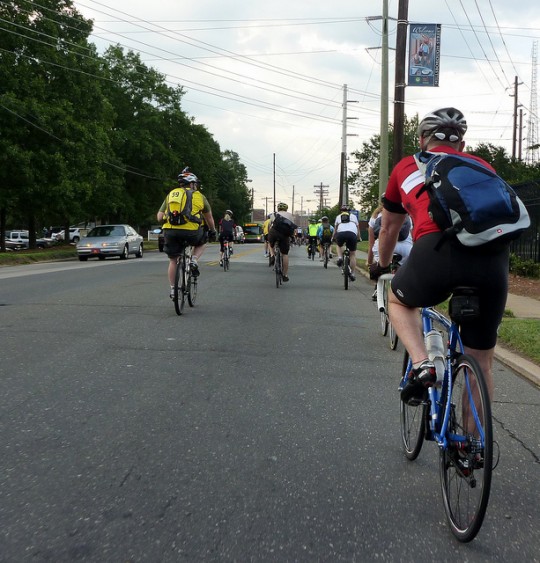Increased use of bikes for commuting offers economic, health benefits
Increased use of bikes for commuting offers economic, health benefits
MADISON – Cutting out short auto trips and replacing them with mass transit and active transport would yield major health benefits, according to a study just published in the scientific journal Environmental Health Perspectives.

The biggest health benefit was due to replacing half of the short trips with bicycle trips during the warmest six months of the year, saving about $3.8 billion per year from avoided mortality and reduced health care costs for conditions like obesity and heart disease.
The report calculated that these measures would save an estimated $7 billion, including 1,100 lives each year from improved air quality and increased physical fitness.
Moving five-mile round trips from cars to bikes is a win-win situation that is often ignored in discussions of transportation alternatives, says Jonathan Patz, director of the Global Health Institute at the University of Wisconsin-Madison. “We talk about the cost of changing energy systems, the cost of alternative fuels, but we seldom talk about this kind of benefit,” he says.
The study of the largest 11 metropolitan statistical areas in the upper Midwest began by identifying the air pollution reductions that would result from eliminating the short auto trips.
A small average reduction in very fine particles, which lodge deep in the lung and have repeatedly been tied to asthma, which affects 8.2 percent of U.S. citizens, and deaths due to cardiovascular and pulmonary diseases, was a major source of health benefits, says co-author Scott Spak, who worked on the study at UW-Madison and is now at the University of Iowa.
“The reductions tend to be much larger during high pollution episodes, and even small changes reduce a chronic exposure that affects the 31.3 million people living throughout the region – not just in these metropolitan areas, but even hundreds of miles downwind,” Spak says.
The study projected that 433 lives would be saved due to the reduction in fine particles.
The second step was to look at the health benefits of using a bicycle on those short trips during the six months with optimum weather, when cycling is quite feasible in the region.
“Obesity has become a national epidemic, and not getting exercise has lot to do with that,” says first author Maggie Grabow, a Ph.D. candidate at UW-Madison’s Nelson Institute, who will present the study today (Wednesday, Nov. 2) to the American Public Health Association in Washington, D.C.
“The majority of Americans do not get the recommended minimum level of exercise,” says Grabow. “In a busy daily schedule, if that exercise can automatically occur while commuting to work, we anticipate a major benefit in stemming the obesity epidemic, and consequently a significant reduction in type II diabetes, which is a deadly epidemic in its own right.”
Overall, the study may underestimate the benefits of eliminating short auto trips, says Patz, an environmental health specialist in the Department of Population Health Sciences, because it did not measure the financial savings due to reduced auto usage. Furthermore, the study did not try to account for the health benefits of the foregone auto trips, which would be performed on foot or via mass transit, both of which provide an additional amount of exercise.
Patz acknowledges that it’s unrealistic to expect to eliminate all short auto trips, but notes that biking as transportation is gaining popularity in the United States, and that in some cities in Northern Europe, approximately 50 percent of short trips are done by bike. “If they have achieved this, why should we not think we can achieve it too?” he asks.
Chicago and New York, among other cities, have devoted significant resources to bike infrastructure in recent years, Patz notes.
The new study, he says, should provide another motivation for making cities more bike friendly, with better parking, bike racks on buses and trains, and more bike lanes and especially separate bike paths.
“Part of this is a call for making our biking infrastructure safer. If there are so many health benefits out there, we ought to try to redesign our cities to achieve them without putting new riders at risk,” Patz says.
By lessening the use of fossil fuels, a reduction in auto usage also benefits the climate, Patz adds. “Transportation accounts for one-third of greenhouse gas emissions, so if we can swap bikes for cars, we gain in fitness, local air quality, a reduction in greenhouse gases, and the personal economic benefits of biking rather than driving. It’s a four-way win,” he adds.
###

Expert on health effects of global climate change, land use change and deforestation; health co-benefits of energy policy
Professor & director, global environmental health
> Areas of expertise
Environmental epidemiology of climate change
Global environmental change and disease emergence
Energy, built urban environments and health impact assessment
> Notable achievements
President, International Association for Ecology and Health
Past co-chair, Health Expert Panel of the U.S. National Assessment on Climate Change
Shared 2007 Nobel Peace Prize as a lead author of United Nations Intergovernmental Panel on Climate Change
Shared Zayed International Prize for the Environment, 2006
Aldo Leopold Leadership Fellow Award, 2005
UW-Madison Romnes Faculty Fellow, 2009
Wrote more than 90 peer-reviewed papers and a textbook addressing the health effects of global environmental change
Invited to brief both houses of Congress, and served on several scientific committees of the National Academy of Sciences
###
Photo by NCDOTcommunications
* The above story is adapted from materials provided by University of Wisconsin–Madison
** About UW–Madison. In achievement and prestige, the University of Wisconsin–Madison has long been recognized as one of America’s great universities. A public, land-grant institution, UW–Madison offers a complete spectrum of liberal arts studies, professional programs and student activities. Spanning 935 acres along the southern shore of Lake Mendota, the campus is located in the city of Madison.
________________________________________________________________




















